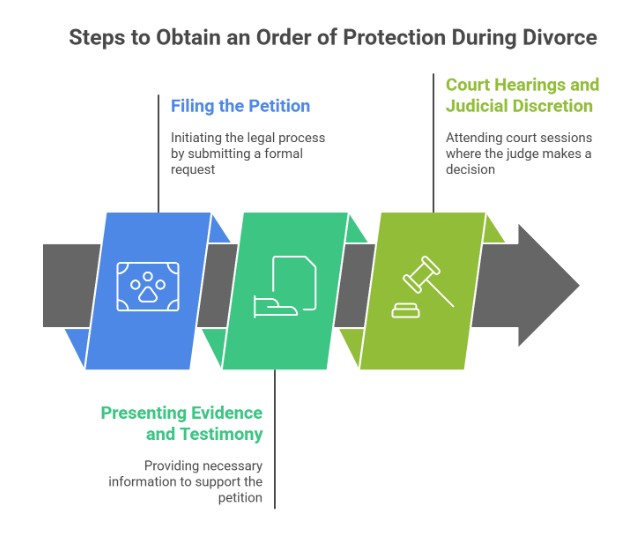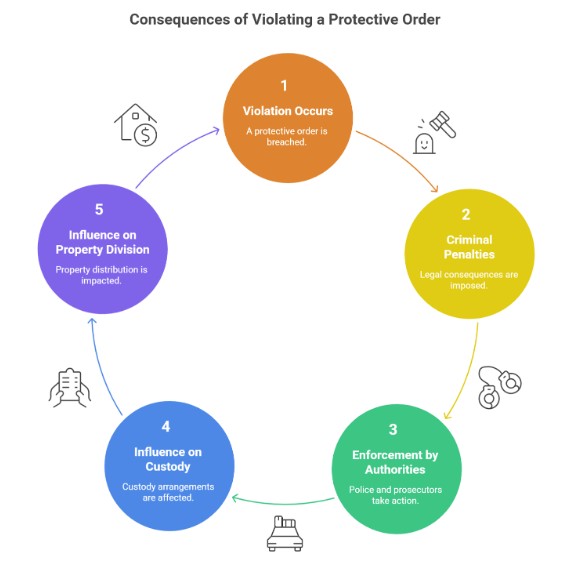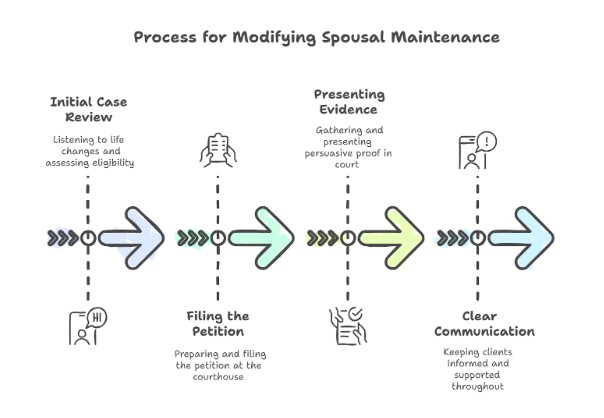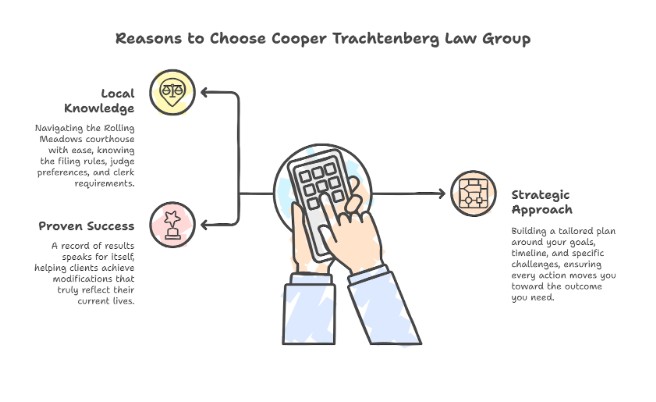Divorce is tough enough on its own. When domestic violence or abuse enters the picture, families need extra legal help to stay safe.
Illinois courts understand this. They offer orders of protection to keep family members safe during and after divorce proceedings.
An order of protection is a court document that stops an abuser from contacting, harassing, or coming near their victim—even during divorce.
Anyone abused by a family or household member can ask for these orders.
They work alongside divorce cases to keep vulnerable family members safe. That’s the bottom line.
Understanding how orders of protection work in Illinois divorce cases helps families make better decisions. You’ll want to know the process, requirements, and what these orders actually do.
Key Takeaways
- Orders of protection legally block abusers from contacting or approaching victims during divorce.
- Abused family or household members can request these orders from Illinois courts.
- Breaking an order of protection can have severe legal consequences and may significantly impact the outcome of a divorce.
What Is an Order of Protection in Illinois Divorce?
An Order of Protection is a legal tool to stop one spouse from contacting or harassing the other during a divorce. These orders protect victims of domestic violence during a stressful time.
Definition Under the Illinois Domestic Violence Act (IDVA)
The Illinois Domestic Violence Act calls Orders of Protection court orders meant to prevent abuse between family members.
The law covers spouses, former spouses, and other family members—pretty much anyone in a household.
Under the IDVA, domestic violence isn’t just physical. It includes harassment, intimidation, threats, stalking, and messing with someone’s freedom.
Judges can issue three types of orders:
- Emergency Order: Lasts up to 21 days
- Interim Order: Temporary protection while the court is ongoing
- Plenary Order: Long-term protection, up to two years
You don’t have to show proof of physical injury. If you’ve got evidence of threats or fear, that’s often enough for a judge to step in.
Common Protections (No Contact, Stay-Away, Temporary Custody, Property Restrictions)
Orders of Protection can set out all kinds of restrictions, depending on what’s going on. The most common ones address contact, location, kids, and property.
Contact Restrictions:
- No phone calls, texts, or emails
- No social media contact
- No contact using third parties
- No sending letters or gifts
Stay-Away Orders:
- Must keep away from the home
- Can’t go to the person’s workplace
- Banned from kids’ schools
- Can’t visit places the person usually goes
Temporary Custody Provisions:
- Temporary custody of children
- Supervised visitation only
- No visitation rights
- Kids covered by the order
Property Restrictions:
- Can’t sell or destroy shared property
- Temporary use of the family home
- Temporary possession of a car
- Protection of personal belongings
When Orders of Protection Overlap With Divorce Petitions
Many people file for divorce and an Order of Protection simultaneously. That’s usually when domestic violence is part of the reason for the split.
You can file the protective order as part of your divorce or as a separate case. Both ways give you the same legal protection.
If both cases occur simultaneously, the protective order often influences divorce decisions. It can impact who gets custody of the kids and who stays in the family home.
Courtrooms focus on safety above all else. If there’s a protection order, that spouse usually gets temporary custody and use of the home while the divorce is sorted out.
The protective order remains active even after the divorce is finalized, although some provisions may be modified according to the final agreement.
If you’re ready to get started, call us now!
Types of Orders of Protection in Illinois

Illinois courts have three main types of protection orders. Each one covers a different time frame and situation.
Emergency orders give immediate safety. Interim orders fill the gap until a full hearing. Plenary orders last up to two years and bring long-term relief.
Emergency Orders of Protection (EOP) — Immediate, Short-Term Relief
Emergency Orders of Protection offer immediate safety if someone’s in real danger. Judges can issue these orders just based on the victim’s word—the alleged abuser doesn’t even have to be there.
These orders kick in right away and usually last 14 to 21 days. That gives victims a chance to breathe and get ready for the next steps.
The court doesn’t need much evidence for emergency orders. If you’re in immediate danger, that’s enough.
Common protections include:
- No contact with the victim
- Abuser must leave shared home
- Stay away from work or school
- Give up firearms
Emergency orders work best when things are urgent. They buy time to gather proof and plan for longer-term protection.
Interim Orders of Protection — Bridge Between Emergency and Full Hearings
Interim orders act as a bridge between emergency and permanent protection. Courts use these after emergency orders run out, but before the big hearing happens.
You’ll need more proof for these than for an emergency order. Both sides get notified, but you might not get a full hearing yet.
Interim orders usually last about 30 days, but courts can extend them.
Key differences from emergency orders:
- Both parties get advance notice
- Stronger evidence required
- Alleged abuser can give some input
- More detailed protection terms
The court looks at evidence more closely for interim orders. Victims should gather any available paperwork, statements, and other relevant proof before requesting assistance.
Plenary Orders of Protection — Long-Term Protection, Up to 2 Years
Plenary orders are the strongest and longest-lasting protection in Illinois. These require a full hearing, with both sides there. It’s smart to have a lawyer for this.
The court wants solid evidence for plenary orders. Victims need to show abuse happened—testimony, documents, medical records, or witnesses help a lot. Both sides can present their case and question witnesses.
Plenary orders can last:
- Up to 2 years at first
- Can be extended with new evidence
- Sometimes permanent in extreme cases
These orders cover everything—exclusive home use, child custody, money, and even counseling.
The process takes longer, but the protection is much stronger. Courts dig deep into the evidence before granting these long-term orders.
Comparison of Emergency, Interim, and Plenary Orders
| Order Type | Duration | Evidence Required | Notice Required | Hearing Type |
| Emergency | 14-21 days | Victim testimony only | None to the alleged abuser | Ex parte (one-sided) |
| Interim | 30 days (extendable) | Moderate evidence | Advance notice given | Limited hearing |
| Plenary | Up to 2 years | Substantial proof | Full notice required | Complete hearing |
Scope of relief grows with each order type. Emergency orders focus on immediate safety. Interim orders add more specific restrictions. Plenary orders can involve complicated arrangements for custody, finances, and property.
Requirements get stricter at every step. Emergency orders need to address basic safety concerns. Interim orders want clearer evidence. Plenary orders require strong proof of ongoing abuse.
Victims often move through all three stages, starting with emergency protection, then interim, and finally plenary if needed.
How Orders of Protection Affect Divorce Proceedings
Orders of protection shake up divorce cases right away. They affect where kids live, how property gets split, and what financial support looks like during the process.
Impact on Child Custody and Visitation
When a court issues an order of protection, it usually spells out what happens with kids and parenting time. The protected parent almost always gets temporary custody right away.
The court might stop visits between the abusive parent and the kids completely. Sometimes, the court only allows supervised visitation—meaning a third party is always present.
These orders can last anywhere from weeks to months. During that time, the custody setup from the order often becomes the default for the divorce case.
Judges take domestic violence seriously when deciding final custody. If a parent has an order of protection against them, they’re going to have a tough time getting equal parenting time.
The protected parent has to show proof of abuse to get these restrictions. Police reports, medical records, and witness statements can help build a strong case.
Impact on Use of Marital Residence and Property Division
Orders of protection often give the victim exclusive use of the family home. This can happen even if both spouses own the house jointly.
The abusive spouse has to leave the home immediately when the order takes effect. They can’t return, not even to pick up personal belongings, unless the court or police allow it.
This living arrangement shapes how courts later divide property in a divorce. The spouse who stays in the home may have a stronger claim to keep it.
Key property impacts include:
- Temporary exclusive use of the marital home
- Restricted access to shared vehicles
- Limited ability to access joint bank accounts
- Prohibition from selling or transferring marital assets
The court may also order the removal of firearms from the home. This protects the victim and lines up with federal laws on domestic violence and guns.
Financial Implications — Temporary Support, Payment Restrictions
Orders of protection can include temporary financial support for the victim and children. The court may order the abusive spouse to keep paying household bills like mortgage, utilities, and insurance.
Common financial orders include:
- Temporary spousal support payments
- Child support during the protection period
- Payment of household expenses
- Health insurance continuation
- Attorney fee assistance
The abusive spouse can’t access joint accounts or credit cards if the order restricts financial abuse. This blocks them from hiding money or cutting off the victim’s funds.
Court-ordered wage garnishment often ensures support payments keep coming. This can give the victim some financial stability during the divorce process.
Who Can Request an Order of Protection in Divorce Cases?
Illinois law lets specific people file for orders of protection during divorce. Parents can also request protection for their kids, and attorneys play a big part in preparing these legal documents.
Eligible Petitioners Under Illinois Law
Primary petitioners include spouses, ex-spouses, and people who share a child. They can file directly with the court.
Family members living in the same household can request protection, too. This covers parents, kids, and other relatives sharing the home.
Dating relationships count under Illinois law. If you’ve dated or had an intimate relationship, you can file for protection from each other.
The person filing has to show they’ve been abused or threatened. Abuse includes physical harm, harassment, or threats of violence.
Courts want clear evidence of the relationship between the parties. Marriage certificates, birth certificates, or other documents help prove the connection.
Age requirements say petitioners must be at least 18. Younger people need a parent or guardian to file for them.
How Parents Can File on Behalf of Children
Parents can file orders of protection to protect their children from the other parent. This happens if there’s evidence of abuse or threats toward the child.
The parent filing needs to provide specific details about the abuse. Courts want clear examples of what happened and when.
Documentation helps build the case. Medical records, photographs, or witness statements can support the request.
Kids usually don’t have to testify. The parent can speak for them and explain why protection is needed.
Emergency situations allow for immediate filing. Courts can grant temporary protection while they review the full case.
The protected child might have limited or no contact with the abusive parent. Courts might order supervised visits instead of regular custody time.
Role of Attorneys in Preparing and Filing Petitions
Attorneys help families determine which type of protection order best suits their situation. Illinois offers different types of protective orders, each with its own requirements.
Legal preparation means gathering evidence and organizing documents. Lawyers are familiar with the information courts typically seek in protection orders.
Attorneys can file the petition directly with the court. This saves families time and helps ensure paperwork gets completed correctly.
Court representation matters during hearings. Lawyers can present evidence and argue for protection.
Free legal help is available through domestic violence programs. These services can help people who can’t afford private attorneys.
Attorneys also explain how protection orders work with divorce cases. They help coordinate both legal processes to keep families protected.
If you’re ready to get started, call us now!
Steps to Obtain an Order of Protection During Divorce

To obtain an Order of Protection in an Illinois divorce, families must file a petition, present evidence, and attend a court hearing.
Filing the Petition (With or Without a Divorce Case Pending)
You can file for an order of protection at any time during the divorce process. You can also file before starting a divorce case.
Filing Options Include:
- Going to the local circuit court clerk’s office
- Having an attorney file the petition
- Requesting the order as part of an existing divorce case
- Getting help from a domestic violence program
The petition must show you need protection from a family or household member. This includes spouses, ex-spouses, people who live together, or people who have kids together.
Required Information:
- Details about the abuse or threats
- Dates and times of incidents
- Any witnesses to the abuse
- Photos of injuries or property damage
- Police reports, if available
The court clerk hands out the necessary forms. Many courts have staff who can help fill out the paperwork correctly.
Presenting Evidence and Testimony
Strong evidence helps judges decide on protection orders. The person asking for protection has to prove abuse happened or threats were made.
Types of Evidence:
- Medical records showing injuries
- Text messages or emails with threats
- Photos of bruises or damaged property
- Police reports from domestic violence calls
- Witness statements from people who saw the abuse
The petitioner should be ready to tell their story clearly. Writing down what happened ahead of time helps. Dates, times, and specific details matter.
Testimony Should Include:
- What the abuser said or did
- How often does abuse happen
- Whether children saw the abuse
- Fear for the safety of the children
Some people are afraid to testify against their spouse. Court staff and victim advocates can offer support during this tough process.
Court Hearings and Judicial Discretion
Judges can grant emergency orders of protection right away. These temporary orders remain in effect until a full hearing, which typically occurs within 14 to 21 days.
At the emergency hearing, only the person seeking protection appears. The judge reviews the petition and determines whether immediate protection is necessary.
The full hearing includes both parties. The accused can bring a lawyer and present their side of the story. Both sides can call witnesses and show evidence.
Judges look at several factors:
- Severity of abuse – How serious the threats or violence were
- Pattern of behavior – Whether abuse happened more than once
- Risk to children – If kids are in danger
- Credibility – Whether the evidence backs up the claims
The judge can grant a plenary order that lasts up to two years. These orders can be renewed if needed.
Importance of Legal Representation From Cooper Trachtenberg Law Group
Having an experienced attorney really matters in protection order cases. Lawyers know how to present evidence effectively and advocate for their clients’ rights.
Benefits of Legal Help:
- Proper preparation of court documents
- Knowledge of what evidence works best
- Experience with local judges and procedures
- Protection during cross-examination
An attorney can coordinate the protection order with the divorce case. This helps avoid conflicts between court orders.
Cooper Trachtenberg Law Group understands how frightening domestic violence situations can get. They help clients feel safe through the legal process.
The firm’s lawyers prepare clients for court hearings. They explain what questions the judge might ask and how to answer in a clear, honest way.
Having legal support takes some pressure off during a stressful time. Clients can focus on their safety and let their attorney handle the legal strategy..
Orders of Protection affect custody, property, and safety. Cooper Trachtenberg Law Group helps families navigate these challenges with care. Don’t wait until it escalates—reach out and contact us now.
What Happens If an Order of Protection Is Violated?
Violating an order of protection in Illinois brings serious criminal penalties and quick law enforcement action. These violations can also affect divorce and custody decisions.
Criminal Penalties for Violating Orders
Illinois treats order of protection violations as criminal offenses with increasing penalties. A first violation usually gets charged as a Class A misdemeanor.
First Offense Penalties:
- Up to 364 days in jail
- Fines up to $2,500
- Probation with strict conditions
Repeat Offense Penalties:
- Second violation becomes a Class 4 felony
- 1 to 3 years in prison
- Fines up to $25,000
Penalties get harsher if the violation involves other crimes. For example, if someone violates the order while committing assault or damaging property, they face charges for both.
Aggravating Factors:
- Physical harm to the protected person
- Violation in front of children
- Use of weapons during the violation
- Previous domestic violence convictions
The court considers these factors when determining sentences. Even attempting to contact the victim through someone else constitutes a violation.
Enforcement by Police and Prosecutors
Illinois has mandatory arrest policies for violations of orders of protection. Police have to arrest someone if they have probable cause to believe a breach has happened.
Officers can’t use their own judgment to skip an arrest. This policy protects victims by ensuring that police act promptly when violations occur.
Police Response Process:
- Investigate the reported violation
- Determine if probable cause exists
- Arrest the violator without a warrant
- File charges with the prosecutor
Prosecutors take these cases seriously and rarely drop charges. They often push for jail time, even for a first offense, to send a strong message.
Evidence Police Collect:
- Text messages or emails
- Witness statements
- Photos of property damage
- Medical records if an injury occurred
The protected person’s consent doesn’t matter. Even if they invite contact, the violation still leads to criminal charges.
How Violations Affect Ongoing Divorce Proceedings
Order of protection violations can seriously affect divorce cases and child custody outcomes. Family courts see violations as evidence of poor judgment or even potential danger.
Impact on Child Custody:
- Reduced parenting time
- Supervised visitation only
- Loss of overnight visits
- Mandatory counseling requirements
Judges put child safety first—always. When someone violates an order, it signals they can’t follow court rules or respect boundaries.
Impact on Property Division:
- May influence spousal support decisions
- Can affect the distribution of marital assets
- Legal fees for violations may reduce available funds
Impact on Future Court Orders:
- The judge may issue stricter protective measures
- Longer duration for protection orders
- Additional conditions or restrictions
Violations create a paper trail. This record sticks with the person through future court proceedings and can sway decisions for years.
Alternatives and Supportive Measures Beyond Protective Orders
Illinois families have a few other legal options and support tools when protective orders aren’t quite the right fit.
These alternatives can help lower conflict and provide safety through various court processes or professional assistance.
Temporary Restraining Orders (TROs) vs. Orders of Protection
Temporary Restraining Orders offer short-term legal fixes in civil matters. They typically last 10-14 days and require a court hearing to be extended.
TROs often arise in property disputes or business conflicts during divorce proceedings. They can freeze assets or limit access to shared accounts in the meantime.
Orders of Protection specifically address abuse and harassment. These orders can last up to two years and are accompanied by more rigorous enforcement.
Key differences include:
- Duration: TROs are shorter-term solutions
- Purpose: TROs handle civil disputes; Orders of Protection address safety concerns
- Penalties: Violating an Order of Protection carries criminal charges
Some families use TROs when they need fast legal help but aren’t alleging abuse. Courts can issue TROs within a day or two if the matter is urgent.
Parenting Coordinators for Conflict Resolution
Parenting Coordinators step in to help divorced parents resolve disagreements about their children. Illinois courts can appoint these trained professionals when communication just isn’t working.
Coordinators make binding calls on day-to-day parenting issues. They handle scheduling, activities, and those smaller disputes that inevitably arise.
Benefits include:
- Reduced court appearances
- Faster problem resolution
- Lower legal costs
- Better communication skills
Parents usually split the coordinator’s fees. Sessions can happen face-to-face, by phone, or over video—whatever works.
Coordinators don’t have the power to change major custody arrangements. They’re there to help enforce what the court already ordered, just more smoothly.
This process works best when both parents actually try to follow the recommendations. Courts can step in and enforce the coordinator’s decisions if someone refuses to cooperate.
Counseling and Support Services for Families
Individual therapy helps family members deal with the stress and trauma of divorce. Plenty of therapists focus on family transitions and domestic issues.
Family counseling can open up communication between parents and kids. These sessions often keep going even after the divorce wraps up.
Support groups connect families with others facing similar issues. Many organizations offer free or affordable group sessions.
Available services include:
- Crisis hotlines for immediate support
- Legal aid clinics for low-income families
- Child therapy programs
- Co-parenting classes
Domestic violence organizations offer safety planning and emergency resources. They provide confidential help—even if families don’t want to go through the courts.
Insurance often covers mental health services. Community centers and religious groups sometimes offer extra support at lower costs.
Why Choose Cooper Trachtenberg Law Group for Protective Orders in Divorce
When safety and stability are on the line, you need attorneys who act quickly and advocate with compassion. Cooper Trachtenberg Law Group has built a strong reputation for guiding families through high-conflict divorces involving protective orders.
The firm moves fast in urgent domestic violence situations, securing immediate protection while managing custody, property, and financial issues that often arise alongside.
Their approach strikes a balance between strategic legal advocacy and human support, providing clients with the reassurance they need during a crisis.
With decades of combined experience, Miriam Cooper and Helena Trachtenberg are recognized leaders in Illinois family law.
Both attorneys have been honored by their peers with prestigious Best Lawyers and Super Lawyers designations, underscoring their authority and credibility in cases involving protective orders and family law.
Your safety and your children’s security matter most. Cooper Trachtenberg Law Group provides trusted representation in Illinois divorce and protective order cases. Take the first step—contact us to schedule.
Contact Us Today For An Appointment
Frequently Asked Questions
What is an Order of Protection in an Illinois divorce?
An Order of Protection is a court order that restricts an abusive spouse or partner from certain actions. In Illinois divorce cases, it may include no-contact provisions, exclusive possession of the home, temporary custody, and restrictions to safeguard children and family members.
Who can file for an Order of Protection during divorce?
Spouses, former spouses, children, household members, or family members can petition for an Order of Protection in Illinois. A parent or guardian may file on behalf of a child, and attorneys can help prepare petitions and present evidence.
How long does an Order of Protection last in Illinois?
Illinois courts issue three types: emergency orders (up to 21 days), interim orders (up to 30 days), and plenary orders (up to 2 years). Plenary orders can be extended if ongoing safety concerns exist.
Will an Order of Protection affect child custody?
Yes. If safety is a concern, courts can restrict or supervise parenting time. Protective orders often influence custody arrangements, prioritizing the child’s well-being while ensuring appropriate safeguards for both parents.
Can an Order of Protection be issued without a divorce case?
Yes. Orders of Protection can be filed independently under the Illinois Domestic Violence Act. However, if a divorce is pending, protective orders may be consolidated into the divorce proceedings for streamlined case management.
What proof is needed for an Order of Protection?
Evidence can include testimony, police reports, medical records, photos, texts, emails, or witness statements. Judges evaluate whether abuse, harassment, or threats occurred and if ongoing protection is necessary for safety.
What happens if an Order of Protection is violated?
Violating an Order of Protection is a criminal offense in Illinois. Consequences may include arrest, fines, and imprisonment. Violations can also impact divorce outcomes, including custody, visitation, and property arrangements.
How do I get an Order of Protection during a divorce?
File a petition with the court, present evidence, and attend a hearing. Emergency orders can be granted quickly without the presence of the other party. An attorney helps ensure petitions are accurate and arguments are strong.























